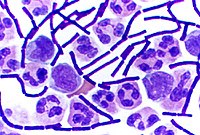
Photo from wikipedia
Purpose To report the clinical settings, causative organisms, antimicrobial susceptibilities, and treatment outcomes of patients with endophthalmitis caused by gram-positive bacteria resistant to vancomycin. Methods Retrospective case series of all… Click to show full abstract
Purpose To report the clinical settings, causative organisms, antimicrobial susceptibilities, and treatment outcomes of patients with endophthalmitis caused by gram-positive bacteria resistant to vancomycin. Methods Retrospective case series of all patients with culture-proven endophthalmitis caused by gram-positive bacteria resistant to vancomycin between January 2010 and December 2016 in LV Prasad Eye Institute, Visakhapatnam, India. Results The current study included 14 patients. The clinical settings were post-cataract surgery in 8/14 (57.1%) and open globe injury in 6/14 (42.8%). Primary intervention for all patients included tap and intravitreal antibiotic injection. During subsequent follow-up, pars plana vitrectomy was performed in 6 patients and one patient underwent penetrating keratoplasty. Mean number of intravitreal antibiotic injections performed were 3.4 per patient. The most common organisms isolated were coagulase-negative Staphylococci in 6/14 (42.8%), Staphylococcus aureus in 5/14 (35.7%), Streptococcus sp in 2/14 (14.2%) and Bacillus sp in 1/14 (7.14%). In addition to vancomycin, resistance to multiple drugs (three or more groups of antibiotics) was found in all 14 cases. Antimicrobial susceptibility results showed susceptibility to amikacin in 7/14 (50.0%), gatifloxacin in 6/14 (42.8%), moxifloxacin in 3/13 (23.0%), cefazoline in 5/14 (35.7%), cefuroxime in 3/14 (21.4%), ciprofloxacin in 2/14 (14.2%) and linezolid in 5/5 (100%). The mean duration of follow-up was 30.7 weeks (6 weeks–90 weeks). At last follow-up, visual acuity (VA) of 20/200 or better was recorded in 7/14 (50%) and VA < 5/200 occurred in 7/14 (50%). Conclusion and importance Antimicrobial susceptibility testing may help in selection of suitable antimicrobial agents for repeat intravitreal injection. Inspite of retreatment with intravitreal antibiotics, these patients generally had poor VA outcomes.
Journal Title: American Journal of Ophthalmology Case Reports
Year Published: 2018
Link to full text (if available)
Share on Social Media: Sign Up to like & get
recommendations!